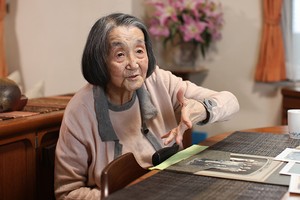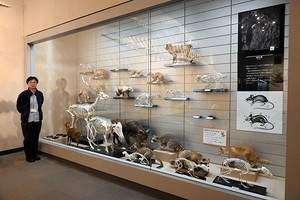THE ASAHI SHIMBUN
March 20, 2025 at 18:54 JST
 A Tokyo Metro Co. official offers a prayer in front of a flower stand at Kasumigaseki Station on March 20. (Pool)
A Tokyo Metro Co. official offers a prayer in front of a flower stand at Kasumigaseki Station on March 20. (Pool)
Shizue Takahashi can still recall details of the day when she learned her husband died a hero during an unthinkable terrorist attack.
“It’s been a long 30 years,” Takahashi, 78, told reporters on March 20 at Tokyo Metro Co.’s Kasumigaseki Station after laying flowers for victims of Aum Shinrikyo’s sarin gas attack.
“Every time I come here, I vividly remember what occurred on that day and feel sadness coming up,” Takahashi said.
She now wants to keep fading memories of the tragedy alive.
On March 20, 1995, Aum Shinrikyo cultists released the nerve gas in five subway cars on the Hibiya, Chiyoda and Marunouchi lines, which were bound for Kasumigaseki Station, during the morning rush hour.
Fourteen people, including Takahashi’s husband, Kazumasa, were killed, and more than 6,000 were injured.
Kazumasa, who was 50 at the time, was assistant stationmaster at Kasumigaseki Station. He removed punctured bags leaking sarin from a subway car and died from the effects at a hospital.
Takahashi, who has offered flowers at the station on every anniversary of the attack, said she is still engaged in a prolonged fight against Aum Shinrikyo’s successor groups.
“It is mortifying to think that I would have lived a different life (had it not been for the attack),” she said.
Takahashi has been at the forefront of a movement demanding compensation from Aum Shinrikyo and has helped establish legislation to provide public relief to victims.
She believes that the attack, which stunned the world, is now sinking into oblivion.
“I want to continue to keep it from being forgotten and also to protect young people from cultists,” she said. “I want people to never forget the attack.”
At Kasumigaseki Station, station employees observed a moment of silence around 8 a.m., when the attack occurred.
Victims and their bereaved family members also offered prayers, while others visited the station to observe the 30th anniversary of the attack.
About 30 members of the Recovery Support Center, a nonprofit organization that has provided care to victims suffering from the aftereffects, presented flowers at the station.
Lawyer Shinsuke Kimura, director of the center, said about one-fourth of the victims the center has dealt with are still suffering from symptoms of post-traumatic stress disorder.
Although the center has decided to disband at the end of March, Kimura said it wants to establish a system that will help reassure victims after disbandment. He also said he wants to continue to be involved.
Shoko Egawa, a journalist who covered Aum Shinrikyo for many years, emphasized that certain elements that allowed the doomsday cult to thrive have remained in society.
“Even today, we can observe at every corner ‘phenomena’ that influence people as Aum Shinrikyo did,” Egawa said. “It is important to pass down lessons to next generations and prevent similar damage.”
Isamu Tomizawa, 57, a central government employee, was using Kasumigaseki Station in 1995. He said that although he was not hit by the nerve gas, he felt that something “kept him alive.”
Many of his young subordinates do not know much about the incident, but Tomizawa said he wants to convey what occurred on that day whenever he has the opportunity.
Yukari Morimoto, 56, a temporary worker, said all subway services were suspended when she was changing trains at Hibiya Station on that day in 1995.
“I might have been one of the victims,” said Morimoto, who visited the flower stand at Kasumigaseki Station for the first time. “There is little I can do myself, but I came here to say that I will never forget the attack.”
(This article was written by Hiraku Higa and Yuji Masuyama.)




















A peek through the music industry’s curtain at the producers who harnessed social media to help their idols go global.
A series based on diplomatic documents declassified by Japan’s Foreign Ministry
Here is a collection of first-hand accounts by “hibakusha” atomic bomb survivors.
Cooking experts, chefs and others involved in the field of food introduce their special recipes intertwined with their paths in life.
A series about Japanese-Americans and their memories of World War II